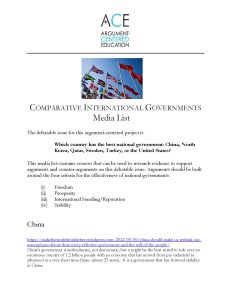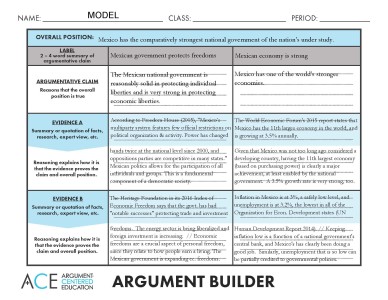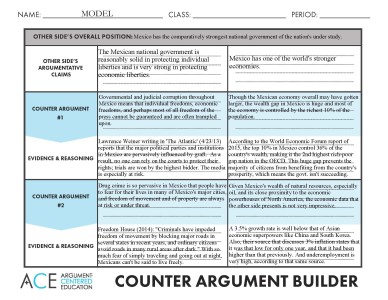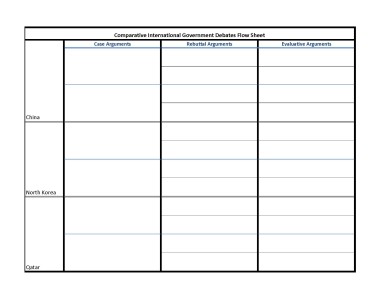
Multi-Sided Debates Comparing National Governments
Comparing and contrasting the policies, practices, achievements, and failures of national governments around the world. This political angle most social science educators and education administrators would identify as essential content in a high school global studies course. And Argument-Centered Education is currently demonstrating how it can be effectively argumentalized, heightening student engagement and its college-directedness. We are working with the social science department of one of our partner schools on multi-sided group debates that compare the effectiveness of six national governments, three democracies and three non-democracies. Teachers selected the countries, to match a larger curricular commitment to exploring these nations within the school’s global studies curriculum. The debatable issue for this argument-centered project is:
Which country has the best national government: China, North Korea, Qatar, Sweden, Turkey, or the United States?
We discussed the question of balance, one of the five key criteria in formulating debatable issues; few international government or foreign policy experts would argue for instance that North Korea has a more effective national government than Sweden. But in the end the department wished to stick with this list of six nations, for three reasons: (i) students have become familiar with and knowledgeable about these nations and some of their recent history through prior lessons, (ii) this unit has as one of its points of focus contrasts between democracies and authoritarian governments, and (iii) there was the view expressed that some students would gravitate toward the challenge of making the more difficult case.
The Implementation Plan lays out the daily schedule over ten days:
 Two days for argument-based content delivery would be too minimal if it were not for the prior lessons that explored the recent political and social history of these nations. The plan of course includes the identification of the criteria which students are to use to build their arguments and counter-arguments. Those four criteria are:
Two days for argument-based content delivery would be too minimal if it were not for the prior lessons that explored the recent political and social history of these nations. The plan of course includes the identification of the criteria which students are to use to build their arguments and counter-arguments. Those four criteria are:
Freedom
To what extent are individual liberties, economic and personal freedoms, and freedoms both “to” and “from” recognized and protected by the government?
International Standing/Reputation
To what extent is the nation and its government respected and well-regarded by other nations and the international community, and to what extent is the national government influential over global affairs?
Prosperity
To what extent is the nation economically prosperous, and how is the national government putting in place policies, assisting and supporting certain industries, and otherwise advancing national prosperity?
Stability
To what extent is the nation and its government and politics peaceful, stable, and socially strong, or to what extent are the signs and effects of the lack of stability in the country?
Students work in groups on making a case that on the basis of some of the above criteria, their country’s national government is highly effective. Students research evidence from an ACE annotated media list —
— building up from the specific detail and factual information about their national government that correspond to the effectiveness criteria listed above, constructing arguments and counter-arguments on forms on ACE organizers like those on the public resources page of the ACE website.
Models are of course crucial, in argument-centered instruction as in just about everything else in education. We created arguments for, and counter-arguments against, the effectiveness of the Mexican national government; it’s always a good idea to use models on a closely parallel but distinct position from the positions that students will be arguing for (and against), since if the parallel is close students can apply what they’ve learned from the model without either trying to replicate (i.e., copy) it, or have one of their best ideas unfairly taken off the table by dint of its use as a classroom model. Those models of arguments and counter-arguments on the Mexican national government are here; we’d encourage you to download and look them over, even if this is not a unit you will want to implement in your school, since if you broaden the parallel there is a lot in these models that is instructive for academic argumentation in social science.
A few points to highlight in the argument builder.
- One of the very common challenges students and even teachers face in using an argument-centered approach is confusion between “overall position” (or just “position”) and “argumentative claim” (or just “claim”). The overall position is the thesis or stance on, or answer to, the debatable issue or question. In this instance, it is the position that one of the listed countries has the comparatively most effective national government. The argumentative claims are reasons that the overall position is true, to be backed up by evidence and reasoning. In this instance, these are the reasons, appealing to the established criteria, that the group’s national government is the most effective.
- One straightforward, scaffolded way that argumentative claims can be taught in this particular multi-sided group debate is to make them simply correspond to the criteria for effectiveness. So, since groups are required to build two arguments for their position, they should pick two criteria that are most favorable to their national government and write simple, formula-based argumentative claim statements for these two criteria — e.g., “[Our country’s] national government has effectively established political and social stability in [our country].” Argumentative claim statements do not have to be this formulaicized — there are of course many different ways to argue for a country’s national government effectiveness drawing on the four broad criteria — but the point here is that they can be, for lesser-experienced academic arguers.
- There may not be enough room on these argument builders for full citations (author, source, date), so students can either supplement them electronically with a source list, or write them in the margins if using the hard-copy versions of these builders. Similarly, when there wasn’t quite enough room in the evidence field for the full quote or paraphrase, we carried the evidence over into the reasoning field and separated evidence from reasoning in this field with a “//”.
- One of the skills in building strong arguments that these builders help develop is prioritizing and careful selection. There isn’t enough room on the builders for all of the evidence students will find to support their claims. The same will be true in their essays and classroom discussions and debates. Students have to learn how to evaluate evidentiary quality and select the better or best evidence. There were lots of macroeconomic data points that are relevant to the claim that the Mexican economy is healthy and growing; we chose for the model (a) data on the international ranking of the overall size of the Mexican economy, (b) the annual growth rate, (c) the current inflation level, and (d) current unemployment numbers. In the reasoning section we explained (very briefly, albeit) the significance of these particular data points.
One point to make about the counter-argument builder. Argument-Centered Education distinguishes between two categories of counter-argument (the subject of a near-future planned Debatifier post): direct and independent. Direct counter-arguments critique the evidence and reasoning of the argument being countered. Direct counter-arguments typically do not present their own evidence; they are direct attacks or critiques of an argument already made defending a competing or contrary position. Independent counter-arguments are reasons that this competing or contrary position isn’t true. They can be completely independent of the argument that they are “countering,” but the better ones undermine an assumption or premise of that argument. Independent counter-arguments always present their own evidence and reasoning, even while they can and often do compare the two pieces of evidence in their reasoning.
Looking at the counter-argument model, the counter-arguments against the Mexican economy argument feature one clear independent and one clear direct example. The counter-argument that the rich-poor gap thwarts the value of a healthy Mexican economy is clearly an independent counter-argument, one with its own evidence and reasoning, and one that effectively undermines the original argument that a large and growing Mexican economy shows that the Mexican government is effective. If that large economy is only really benefits the wealthiest segment of the Mexican society, it is not a strong argument for the national government’s effectiveness. The second counter-argument is clearly direct, since it critiques and re-interprets the macroeconomic evidence in the original argument, attempting to cast doubt on whether it actually proves that the Mexican economy is large and robust.
The speech sequence in this multi-sided group debate project identifies which group develops counter-arguments, into a rebuttal, against which other group. Each group is assigned, in other words, one other group (i.e., one other national government) to build counter-arguments against. Those pairings are found on the speech sequence document:
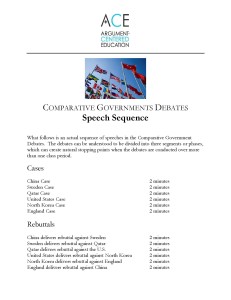 Now, even though each group is responsible for constructing and delivering a rebuttal against only one other group, in the evaluation speeches which follow the rebuttals, groups have to make comparative and evaluative argumentation that supports their national government over the national governments of the other five countries. So they will have to be listening carefully and of course tracking all of the argumentation taking place throughout the debates.
Now, even though each group is responsible for constructing and delivering a rebuttal against only one other group, in the evaluation speeches which follow the rebuttals, groups have to make comparative and evaluative argumentation that supports their national government over the national governments of the other five countries. So they will have to be listening carefully and of course tracking all of the argumentation taking place throughout the debates.
The Overview lays out further details on the debates and the project. It culminates in actual debates that should be tracked (or “flowed”) by every student and by the teacher on a projector, providing an official record of the debates.
After the debates, students write an on-demand argument essay in which they are able to argue for any of the six countries as having the most effective national government. They are not required to write in favor of the country that they argued for in the debates. They are required, however, to build from the arguments made in the debates; they are responsible for answering the best counter-arguments and argument evaluations made in the debates for a contrary position, and they should try to go one step beyond the evidence presented.
This multi-sided group debate project is an example of an argumentalized approach to a complex but essential content area in global studies curriculum, bringing together college-readying skills with discipline-specificity. When teachers become comfortable with the format, its implementation pacing, and the argumentational standards and practices it applies, secondary school students at all performance levels (as long we expect them to become college-ready) flourish with it.


